Office & workplace / Healthy Cities
A healthy ecosystem of work: making the hybrid possible
By Muriel Altunaga, Yvonne Pinniger and Namrata Krishna | 26 Mar 2021 | 0
This paper shares the findings from a virtual workshop that generated insights into the creation of a healthy ecosystem of work for knowledge workers.
Authors of scientific paper:
Abstract
This workshop will focus on creating a healthy ecosystem of work, including and beyond the office.
We will never come back to the way we lived before January 2020. In a matter of weeks, the Covid-19 pandemic transformed ways of working across the world that decades of workplace strategy and consulting hasn’t been able to. In lockdown, we have all experienced a dramatic shift in how we think about what we need from work, the spaces in which we work, and for whom we work.
Our workshop is set in two years’ time, in a post-Covid vaccine world. We have gone beyond the first panic-driven responses and adapted to a new normal, but how we interact has irrevocably changed. We now know that we are vulnerable, that another pandemic could happen at any time. Building on the valuable lessons we have learned collectively – across myriad disciplines including health, economics, spatial design, and data science – our workshop will focus on creating a healthy ecosystem of work, including and beyond the office. It will explore what an ideal ‘work day in the life’ looks like for two extreme personas at opposite ends of how they want to engage with people and their environments. We will include key provocations around changing values and needs for an ecosystem of choice, tools, community and amenity in the world of work, responding to a collective focus on health and wellness. Bringing our expertise in workplace experience, design, strategy and behaviour change, we will first set the context for the world of work before, during and after the pandemic.
Using a co-design approach and user-experience frameworks and tools, we will then hand over to participants, asking them to align themselves with a persona. Through prompts to help them embody their chosen user, we will guide them through a series of exercises that asks them to collaboratively imagine what they need from their workplaces, as well as what they are afraid of experiencing and how that can be mitigated. This intelligent interrogation with sector experts and peers will give voice to multiple perspectives and also make visible the role of design and design thinking in tackling such issues.
Finally, we will analyse and synthesise the workshop output into a findings and recommendations report for workshop participants. This will provide suggested approaches on how we can begin engaging with clients and end users to design a healthier, more meaningful, and pluralistic workplace.
Keywords
As part of the Healthy City Design International Congress 2020, CBRE and Heta Architects partnered to design and facilitate a virtual workshop to explore, post-Covid, what a healthy, hybrid ecosystem of work looks like, including and beyond the office. We ‘set’ the workshop in two years’ time, when widespread vaccination has enabled us to adapt to a new normal, building on the valuable lessons we learned during the pandemic.
We invited a group of experts across disciplines – including health, architecture, design, and planning – to participate, sharing their knowledge and experience while also diving into what an ideal working ‘day in the life’ looks like for two very different personas in extreme scenarios, one working fully from home and another fully from the office. Through discussion around the key challenges and enablers in each scenario, we were able to understand what is really needed in a hybrid environment, which everyone agreed is the ideal. We also decided to harness the benefits of a virtual workshop to allow for extended audience participation, using digital tools such as Miro, a brainstorming platform, and Mentimeter, an interactive survey and presentation software.
The key aims of the workshop were to tap into the diverse expertise in the room, share a multi-faceted, human-centred and interactive approach to the world of work, and use human-centred design tools to understand what makes this ideal ecosystem possible.
Setting the scene beyond the pandemic
We began the workshop by setting the scene and sharing what we as design strategists see as the important shifts in what knowledge workers need from work, the spaces in which we work, and for whom who we work, drawing on current research as well as our expertise in workplace design. In lockdown, where a much greater population was forced to work remotely and collectively, practically overnight, changes that were already happening and had been on our radar for a while were accelerated.
CBRE’s studies into flexible working showed that people want a balance of being able to work remotely but also come into the office – an office that may have to be designed differently to accommodate hybrid working and digital nomads, as well as a workforce that is looking for a strong brand presence and connection to an organisation. The shared move to home working was also a mass behaviour change experiment, forcing people to try doing things in new ways, be nimbler, and re-evaluate what really matters to them – namely, choice and flexibility, personal relationships, and empathetic leaders with high emotional intelligence. These changes in turn have impacted the world we want to build around us; we’re living and learning in new patterns and creating new rituals based on our individual needs, meaning that our working communities must consider not just the physical but the full 360° experience.
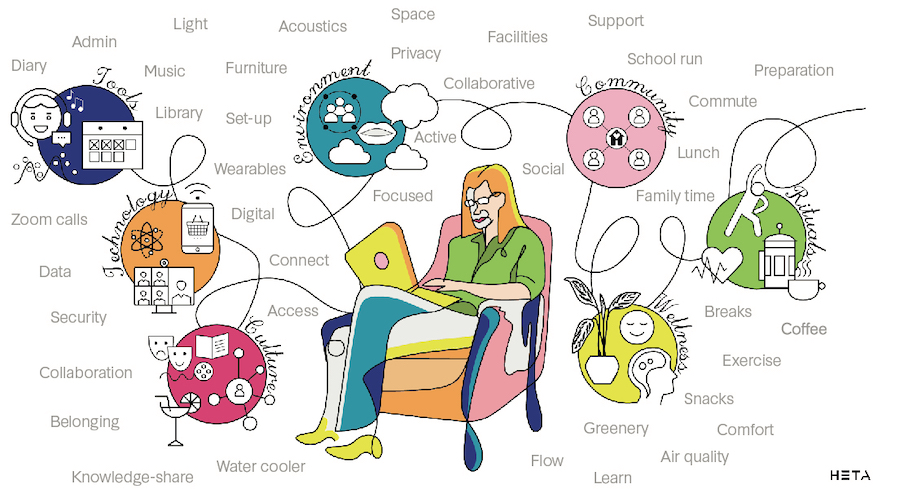
Inhabiting personas for deeper understanding
Moving on to the workshop activities, we became acquainted with two personas, Adele and Lee, to explore their different respective experiences of working exclusively at home and exclusively in the office. These personas are characters we created to better understand the aims, needs, desires and experiences of different user types, allowing participants to ‘walk in their shoes’. Adele and Lee have very different demographics, lifestyles and workstyles, but both are full-time knowledge workers in large organisations. We decided to focus on knowledge workers to create some structure and specificity, but equally because they’re the fastest-growing sector of the workforce globally and tend to be the trendsetters for other sectors.
Adele is 54 and lives with her partner, two teenage daughters and their two dogs just outside of London. She is a leader at home, at work and in her local community, and prioritises health and wellbeing for herself and her family. She has a lot of autonomy when it comes to planning how and with whom she works, and does a range of tasks across a workday.
Lee is a 23-year-old recent graduate who moved to London for his first full-time role. He lives with several flatmates and has a few family friends, but most of his social circle was formed through work. As a junior, Lee is mostly working with others, continually learning, and needing guidance and mentoring throughout his day.
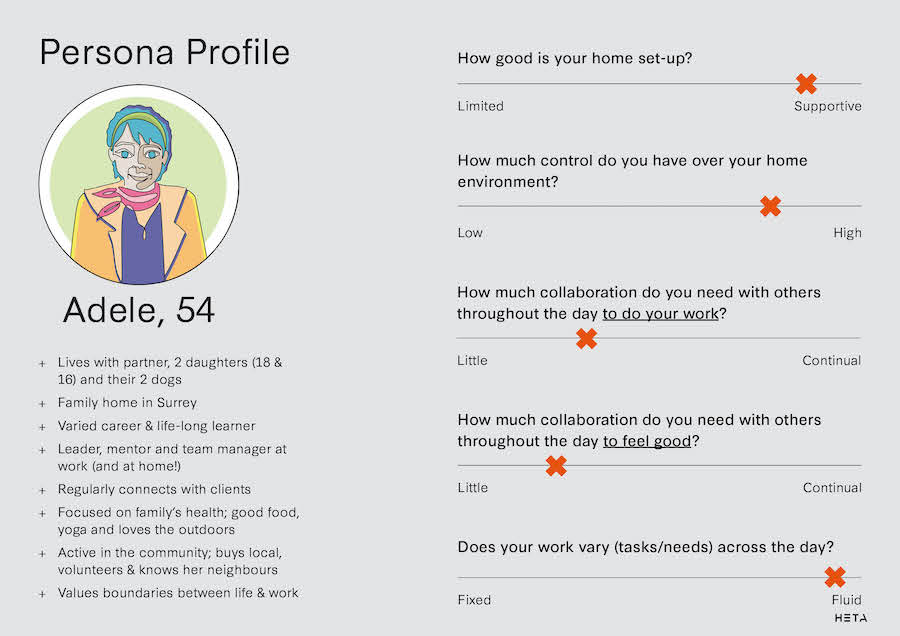
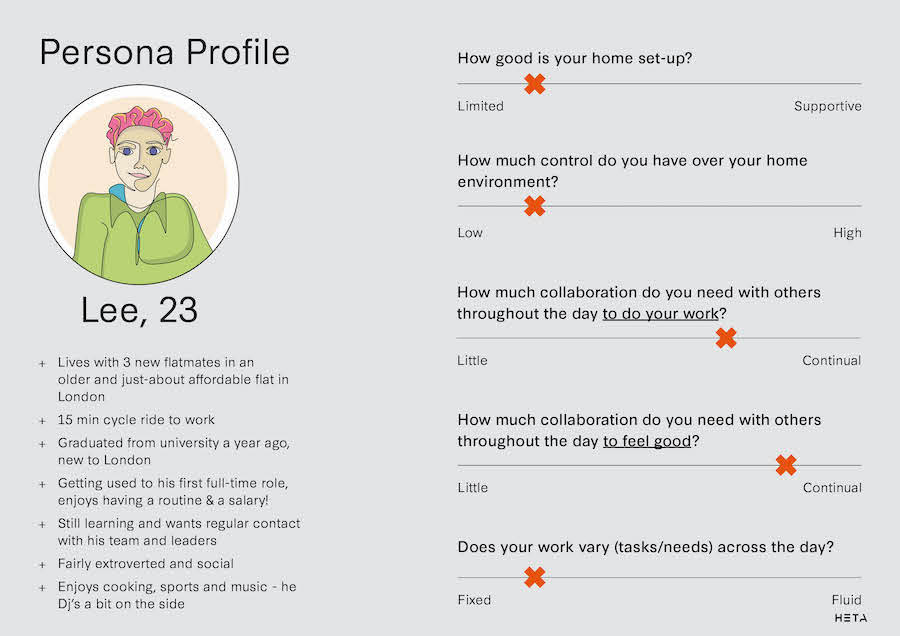
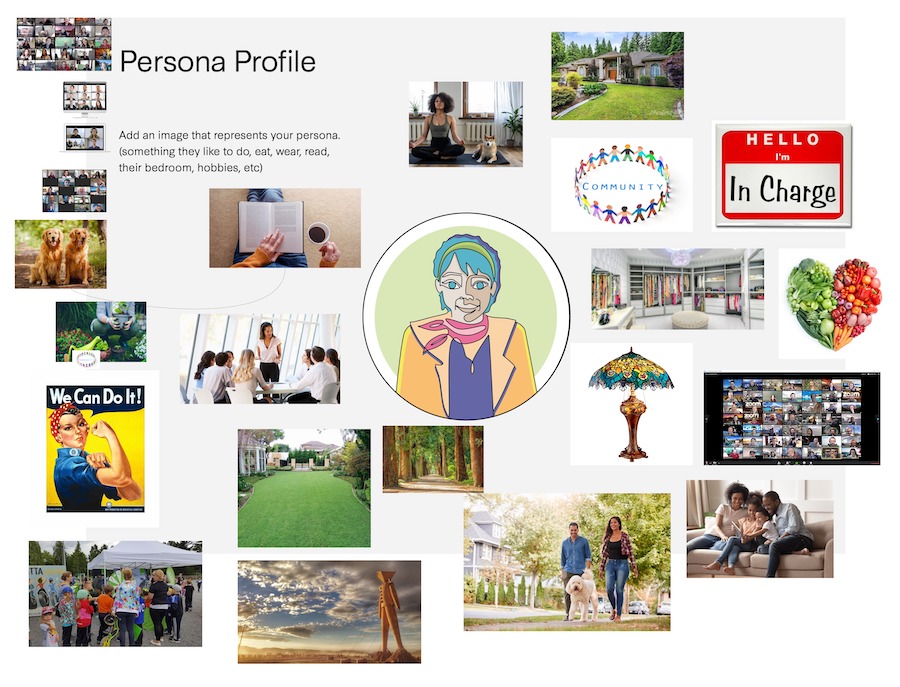
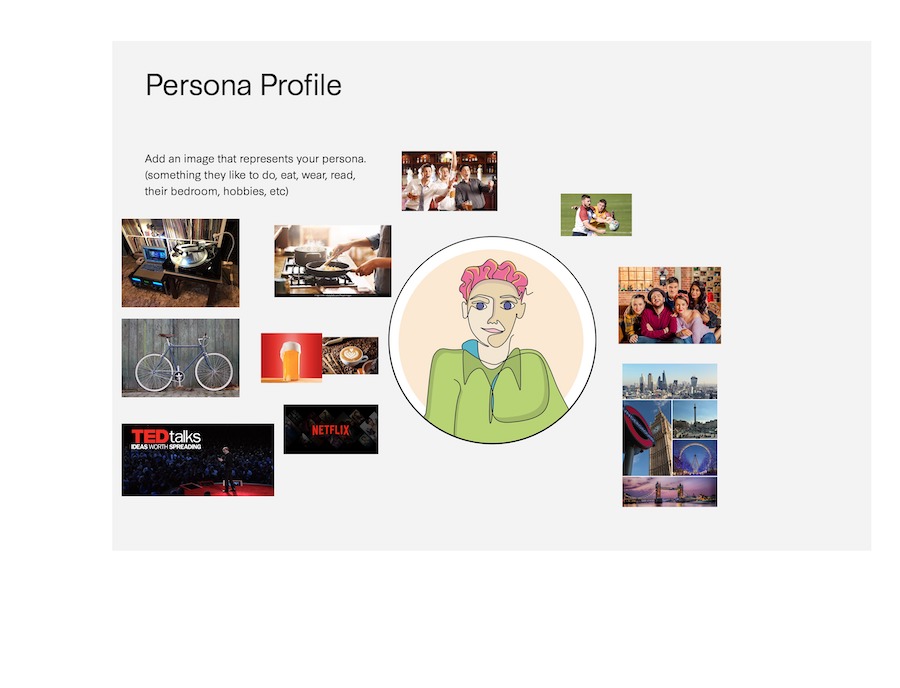
A confluence of needs across personas
Key themes emerged around the ideal environment and behaviours that would support both Adele and Lee, and everyone who sits in between them, to work at their best, and these are what we feel need to be the main considerations around creating a healthy, hybrid ecosystem.
Given the differences in their backgrounds, our participants did document contrasting working experiences for Adele and Lee. What was most interesting, however, was that though the reasons for them might not have been the same, there was a large degree of overlap in what Adele and Lee needed and wanted from work in both scenarios.
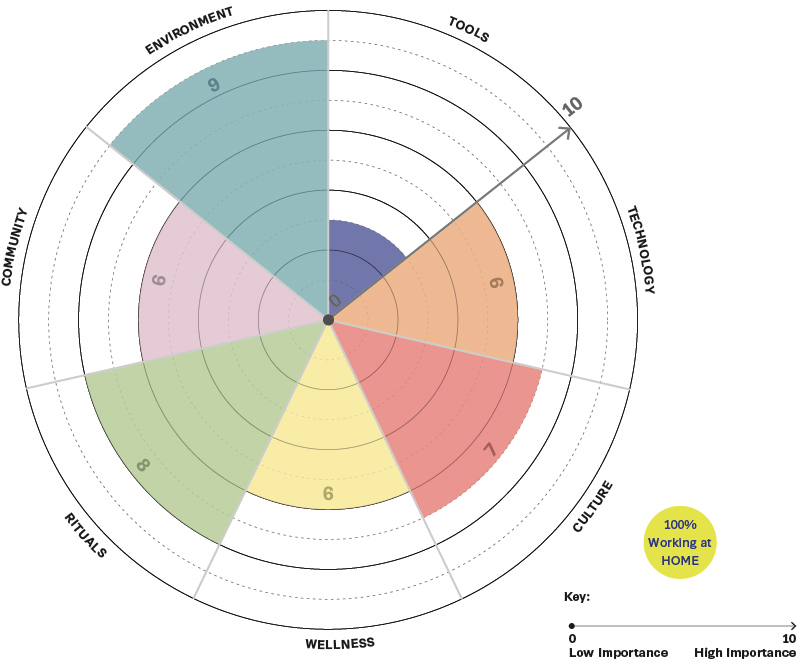
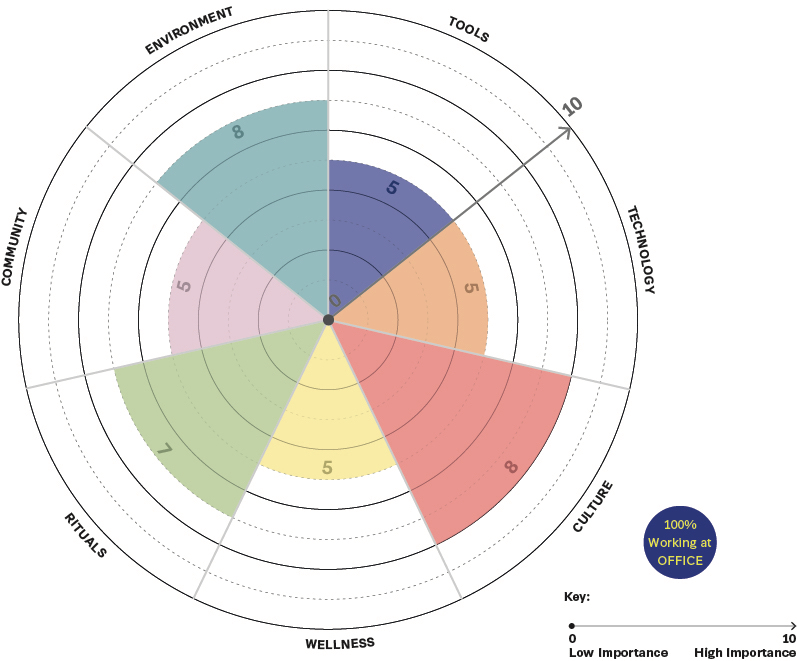
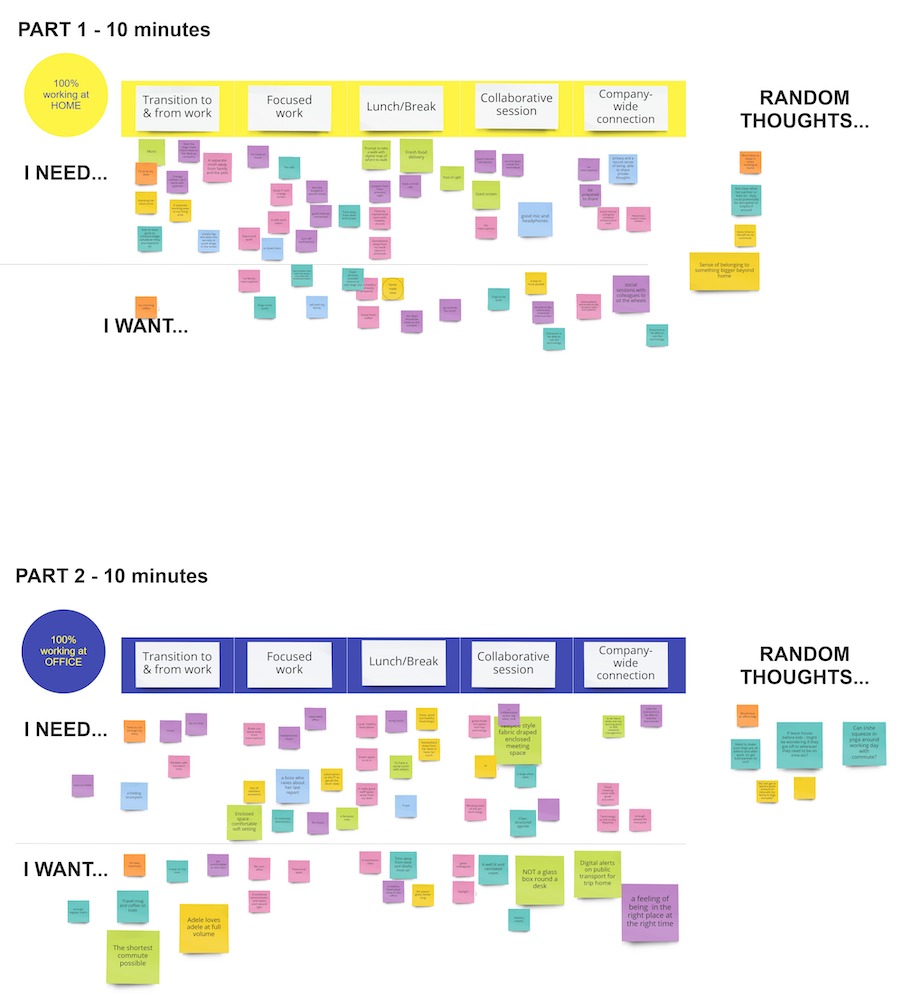
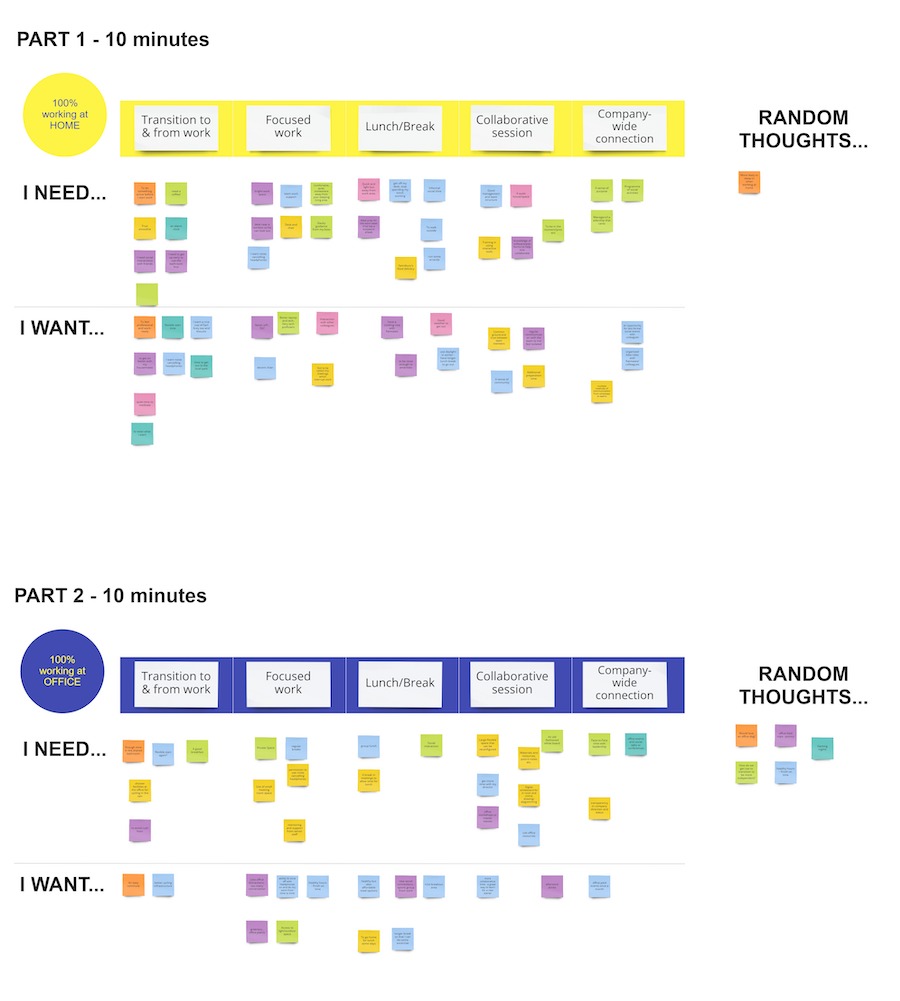
Combining our findings told us that there’s more to consider when working at home. This is likely to be because: firstly, the office is designed for work (fit for purpose) and so has already captured many user work needs; and/or secondly, owing to the naturally higher degree of autonomy and flexibility of working from home, along with differences in people’s home environments, the experience is far more multi-faceted and open-ended. Additionally, needs and wants relating to ‘culture’ are as important at home as in the office, featuring prominently in both scenarios.
The most surprising insights around employee needs
There are, of course, a whole host of factors that contribute to creating an ideal work environment, but below are some of the insights that participants raised in their consideration of what their personas would most value throughout a working day.
Peace and quiet
The need for a separate environment or workspace played a higher role at home, beyond just creating boundaries between personal and professional. Preventing noise and distractions throughout the day was felt to be a necessity, whether undertaking focused work or participating in a group call or collaboration. The fear of being interrupted or disturbed became in itself a distraction from work, requiring more preparation and negotiating one’s environment with fellow habitants.
Convenience and proximity
Convenience and proximity to amenities, such as specialist workspaces, outdoor environments, food prep/eating facilities, exercise or class facilities, and life admin resources (such as deliveries, dry cleaning, etc) are important on a daily basis. For many high-performing workplaces, these amenities are often available within easy walking distance in urban environments, or consciously built into the planning of all-encompassing campuses. Business districts are designed around worker needs, but when working solely from home, people found they were missing some of the really valuable services they could access during brief breaks in the workday, such as healthy ‘fast food’, green space, or gyms. In a residential scenario, we may now need further investment in a variety of amenities to also support the demands of people working remotely, to better match what people get in and around their offices.
“[The challenge is] how we create a flexible hybrid system that works across all skills, areas, demographics. Planning and developing need to accommodate everything we need across work and living.”
– Suzanne MacCormick, WSP UK
Access and control
Despite our growing dependence on technology to support work in and outside of the office, there was a surprisingly low reference to technology needs overall; this could be in part because of the ubiquity and assumption of knowledge workers having good technology and connectivity to work well. However, it’s interesting to note that many of the comments around technology were referencing a need for it to ‘stop’ – whether to stop notifications and calls during focused periods, or to reduce screen time, the desire to put a halt on our reliance on technology as the only means of communication and ‘always be on’ has increased during the pandemic.
“We’re not very good at slowing down and things move too fast when enabled by technology. [There’s] no down time or time to think – we lose quite a lot of innovation and become far too procedural.”
– Oliver Jones, Ryder Architecture
Negotiable time
Given the experimentation and challenges around scheduling work time during the pandemic, continuing to have flexibility and control over managing time has, in many cases, become critical. Flexibility around start times at home to factor in negotiating quiet/private workspace or to skip rush hour to improve the commute to and from the office, allowing for longer lunch breaks to make the most of face-to-face hours with colleagues or preparation and social time at home, and adjusting work hours to make the most of daylight for outdoor activities and exercise all rated highly.
Supportive culture
As previously mentioned, workplace culture was one of the key areas that came up repeatedly in both scenarios. At home, this tended to be more about leadership, training and support, and in the office, it was more about autonomy, identity and belonging. This is likely because these are the areas that people feel are more lacking in the opposite scenario – for example, when working from home most people automatically have more autonomy because they’re less visible, but they could feel more isolated and disconnected from their colleagues. This is another critical argument in support of hybrid working – both environments nurture us in different ways, and we’ll continue to need both of them.
“We have to get leadership to understand the shift to the ‘new normal’ and envisaging what employees need.”
– Mario Bozzo, SALUS Global Knowledge Exchange, UK
Rapid-fire recommendations from our expert participants
To wrap up the workshop, we asked our group of expert participants to highlight, in 120 seconds or less, what they felt the primary enablers to creating this ideal ecosystem were, with the following factors emerging as most important to consider:
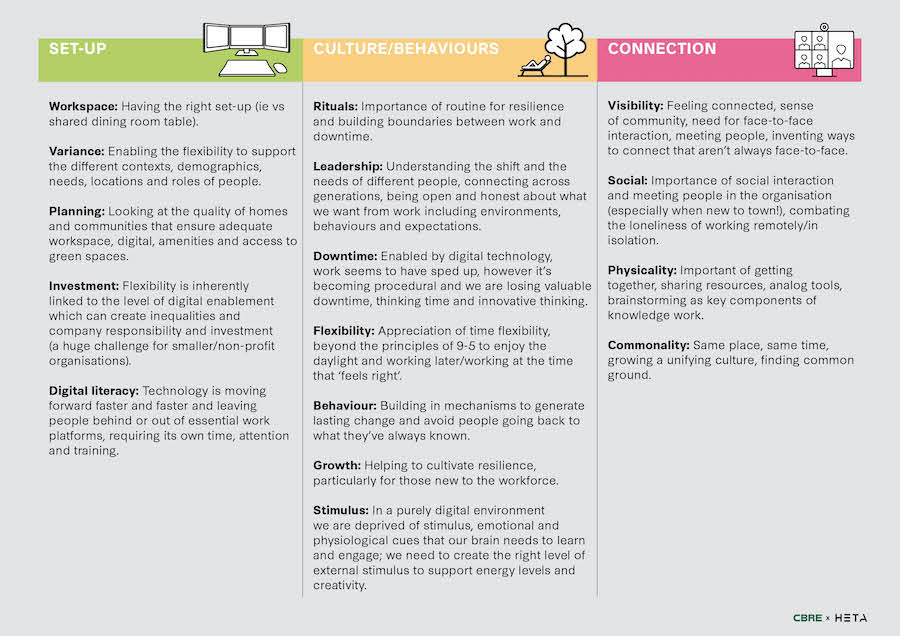
Making the hybrid possible and tangible
The technology, processes and tools, and the level of independence of knowledge workers allows employees to work in the combination that best suits their work/life set-up and needs, from working in the office every day to working full-time from home.
A hybrid approach allows employees to have the best of both worlds. For many, working from home enables work-life flexibility, the comforts of home, hours of focused concentration, and reduced commuting time. On the other hand, the office facilitates face-to-face interaction and spontaneous encounters, increasing collaboration and creativity. Office presence also enhances team integration, increases the employee brand experience and the sense of belonging to the team, organisation and wider purpose.
What is clear from our collective experience this last year, and the workshop itself, is that the hybrid approach demands consideration; it affects individual and team behaviours, commands new rituals and tools, and requires robust and supportive technology, as well as new requirements from work and home environments. The new arrangement calls for a strong commitment, good infrastructure and planning, and an integrated approach across the full ecosystem of work to be sustainable.
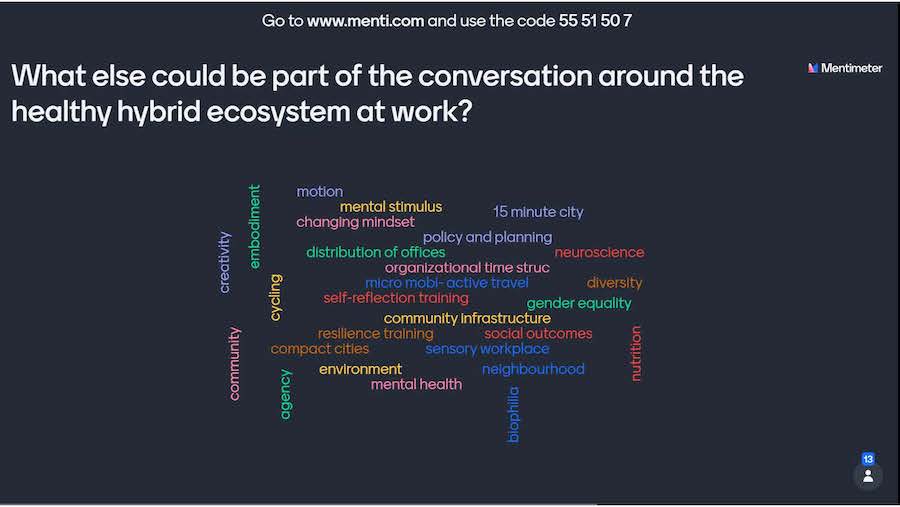
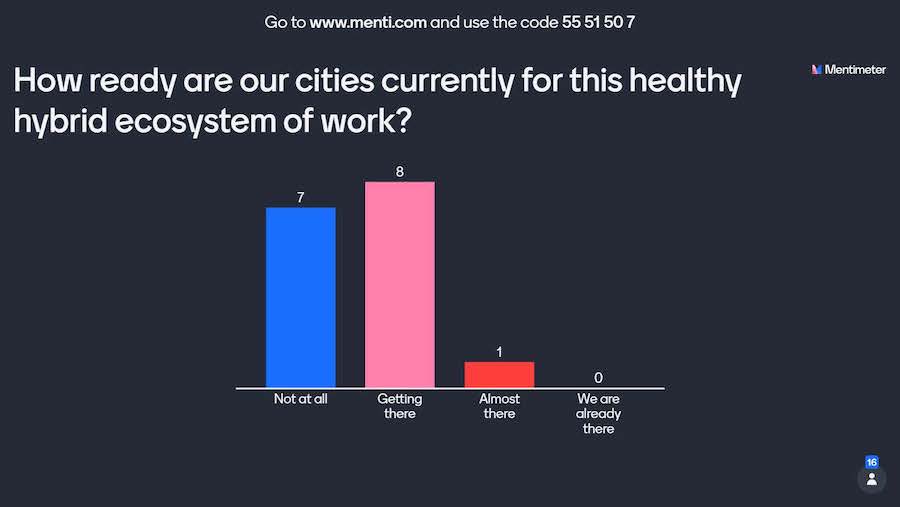
When looking ahead at a healthy, hybrid ecosystem of work we see a multi-layered impact, which influences individuals, organisations and cities.
Individuals
Working from home requires a new culture, with new routines agreed and set by team leaders and members that respect individual and collective boundaries and arrangements. An increased emphasis on knowing where, when and how to work individually and collaboratively will require strategies that are personalised for each person, his or her location, resources and organisation. This means developing greater levels of emotional intelligence and awareness, and acquiring new abilities such as self-reflection, paying more attention to our own wellbeing needs, and knowing, communicating and building in requirements whether at home, in the office, or somewhere in between.
Organisations
Employers seeking to empower their people through hybrid working need to consider the employee experience across the full ecosystem of work and how this can facilitate individual as well as team objectives and needs. The paradigm of remote working – ‘just because you can, doesn’t mean you should’ – demands that roles across an organisation consider team priorities before organising individual agendas, while still ensuring personal choice. There will also be a need to develop a hybrid working culture that’s specific to each organisation, and that includes access to and training in suitable tools, resources, amenities and behaviours to support remote work. Office design will continue to require a deep understanding of users’ needs and digital integration, as well as the ability to allocate space based on varying requirements.
Cities
Our homes, neighbourhoods and cities need to evolve. Working more frequently from home places different demands on the spaces in which we live, including more emphasis on ergonomics and comfort. Remote working will have an impact on surrounding amenities and third places, such as green spaces and co-working hubs. Opportunities for local businesses and other spaces to accommodate the dispersed workforce within current business districts and, typically, residential areas could change the city centre’s strong nine-to-five weekday mood, resulting in a new arrangement that will shift the urban dynamic.
About the authors
Namrata Krishna is a design strategy lead at Heta Architects. As part of Heta’s Design Advisory team, she works with clients through strategic design and behaviour change, with a strong focus on narrative to create spaces and experiences that are unique, immersive and meaningful. Yvonne Pinniger is an independent consultant working with clients in the UK and Australia. Her background is a blend of research, design, strategy and engagement to help clients and communities generate collective prosperity within the built environment. Yvonne formerly led Design Advisory at Heta Architects. Muriel Altunaga is a director at CBRE’s EMEA Design Hub. Muriel is senior architect with 20-plus years of experience in workplace strategy, change management, interior design and build. A skilled strategist, she has an extended track record in the implementation of new ways of working, enhancing the workplace concept through a holistic, user-centred approach.
References
No references.
Organisations involved

